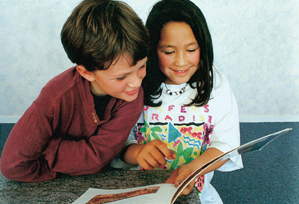![]() GENDER
DIFFERENCES IN ATTITUDES TO READING
GENDER
DIFFERENCES IN ATTITUDES TO READING
![]()
Liz
Eley
While
the difference in achievement of boys and girls in reading is
well documented, there are many factors that influence student
achievement. The factors identified as having a positive effect
on student achievement are being positive, enjoying the learning
area, and seeing a purpose for what is being learned. Other factors
affecting student achievement include experiences and opportunities
in and out of school, the expectations and support of significant
people in students’ lives, and the extent to which students
experience personal success in the subject. This study examined
the differences in responses by boys and girls to 24 questions
designed to determine their reading attitudes and habits. |
The
questionnaire was administered as part of the 2000 NEMP assessment of
reading. Approximately 460 Years 4 and 8 students answered the questions
on their own, but with a teacher available to assist with reading questions
and/or recording responses. They were asked three types of question: Likert-type
scale questions, choosing responses from a list of options, and open questions.
| •
In terms of favourite subjects at school, reading was more popular
at Year 4 than Year 8. Students were very positive about reading at
school, with nearly 90% giving a positive rating when asked how much
they liked doing this. • At Year 4, boys liked reading at school more than girls did, but at Year 8, girls were more positive than boys. • Students had a very positive perception of their reading ability—girls more so than boys. A high proportion of students reported that they did not know how good their teacher thought they were at reading. At both age levels, girls were more likely than boys to report this. • Having the teacher read to the class was the most popular reading activity, with girls more positive than boys about this at Year 4 and boys more positive at Year 8. |
•
Reading out loud to the class (i.e., the student doing the reading)
was the least popular reading activity, with boys less positive about
this than girls. • Reading for leisure was a popular pastime, with girls more positive about this than boys. • Younger students were much more positive than older students about getting a book for a present. Girls were also more positive about this than boys. • Fiction was the preferred reading material for leisure by Year 4 girls and boys and Year 8 girls. Year 8 boys identified magazines as their preferred reading material. Interest in non-fiction decreased between Years 4 and 8, although boys at both levels expressed a greater interest in this type of reading material than did girls. |
![]()

The survey confirmed that reading at school is very popular with students
and highlighted that students perceive themselves as good readers at home.
This enjoyment and positive attitude should have a positive influence
on further success in reading. However, boys’ decreasing enjoyment
of reading at school as they get older is of concern. This consideration
and the different types of reading material that students choose for their
leisure reading highlight the need to carefully select texts for reading
instruction that cater for individual interests.